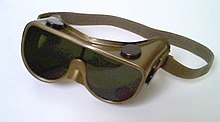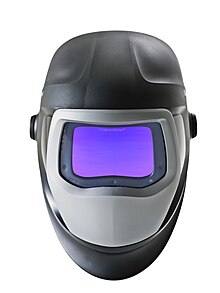


Awelding helmet is a type of personal protective equipment used in performing certain types of welding to protect the eyes, face, and neck from flash burn, sparks, infrared and ultraviolet light, and intense heat. The modern welding helmet used today was first introduced in 1937 by Willson Products.[1]
Welding helmets are most commonly used in arc welding processes such as shielded metal arc welding, gas tungsten arc welding, and gas metal arc welding. They are necessary to prevent arc eye, a painful condition where the cornea is inflamed. Welding helmets can also prevent retina burns, which can lead to a loss of vision. Both conditions are caused by unprotected exposure to the highly concentrated infrared and ultraviolet rays emitted by the welding arc.[2] Ultraviolet emissions from the welding arc can also damage uncovered skin, causing a sunburn-like condition in a relatively short period of welding. In addition to the radiation, gases or splashes can also be a hazard to the skin and the eyes.[3]
Most welding helmets include a window (visor) covered with a filter called a lens shade, through which the welder can see to work. The window may be made of tinted glass, tinted plastic, or a variable-density filter made from a pair of polarized lenses. Different lens shades are needed for different welding processes. For example, metal inert gas (MIG) and tungsten inert gas (TIG) welding are low-intensity processes, so a lighter lens shade will be preferred.
United States OSHA requirements for welding helmets are derived from standards like ANSI Z49.1, Safety in Welding and Cutting, section 7 (Protection of Personnel)[4] and ANSI Z89.1 (Safety Requirements for Industrial Head Protection).[5]
The shade of lens that is suitable depends on the current rating of the weld. In the United States, OSHA recommends DIN shade numbers as shown in the following table:
| Weld Current (Amperes) |
Shade Number |
|---|---|
| 50–60 | 10 |
| 60–160 | 11 |
| 160–200 | 12 |
| 200–240 | 13 |
| > 240 | 14 |
The 1967 edition of ANSI Z49.1.7.2.2.10 specifies that "all filter lenses and plates shall meet the test for transmission of radiant energy prescribed in paragraph 6.3.4.6 of the Safety Code for Head, Eye and Respiratory Protection, USA Standard Z2.1-1959".[4]
As of 2023, OSHA's website provides standards for minimum protective shades under standard 1910.133 (Eye and face protection), section (a)(5), and says: "As a rule of thumb, start with a shade that is too dark to see the weld zone. Then go to a lighter shade which gives sufficient view of the weld zone without going below the minimum. In oxyfuel gas welding or cutting where the torch produces a high yellow light, it is desirable to use a filter lens that absorbs the yellow or sodium line in the visible light of the (spectrum) operation."[6]
All welding helmets are susceptible to damages such as cracks that can compromise the protection from ultraviolet and infrared rays. In addition to protecting the eyes, the helmet protects the face from hot metal sparks generated by the arc and from UV damage. When overhead welding, a leather skull cap and shoulder cover are used to prevent head and shoulder burns.[7]

Welding goggles are protective eyewear that has dark shading, meant to protect eyes from the bright light produced by oxyfuel welding and allied processes, and also from sparks and debris.[8] Open electrical arcs (as created by arc welding and other processes) generate much higher amounts of light and UV radiation, requiring the whole face to be protected; most welding goggles do not have a dark enough shade for arc welding.

In 1981, Swedish manufacturer Hornell International (now owned by 3M[9]) introduced an LCD electronic shutter that darkens automatically when sensors detect the bright welding arc,[10] the Speedglas Auto-Darkening Filter.
With such electronic auto-darkening helmets, the welder no longer has to get ready to weld and then nod their head to lower the helmet over their face. The advantage is that the welder does not need to adjust the position of welding helmet manually, which not only saves time but also reduces the risk of exposure to the harmful light generated by the welding process.
In the United States, the industry standard for welding helmets is ANSI Z87.1+, which specifies performance of a wide variety of eye protection devices. The standard requires that auto-darkening helmets provide full protection against both UV and IR even when they are not in the darkened state.[10] The standard is voluntary, so buyers should confirm that the helmet is ANSI Z87.1 compliant (indicated by appropriate labeling).
Per ANSI Z87.1-2003,[11]: 42 "shade numbers" are derived as such:
Shade Number,
, is related to luminous transmittance
(expressed as a fraction, not as a percent) by the equation:

The actual ANSI-specified shades are not specific numbers, but ranges; each has a designated maximum, minimum, and nominal transmittance value. Moreover, acceptable transmittance values for far ultraviolet are far lower than those for the Illuminant A light ("shall be less than one tenth of the minimum allowable luminous transmittance").[11]
While ANSI shades are ranges based on a specific illuminant, and do not directly convert into other measurements of transmittance, the following table gives a rough approximation (in terms of neutral density filter numbers and f-stops).
| Notation | Lens area opening, as fraction of the complete lens | f-stop reduction (approx.) | ANSI shade (approx.)[11] | Fractional transmittance | ||||
|---|---|---|---|---|---|---|---|---|
| Optical density | ND1number | ND.number | NDnumber | |||||
| 0.0 | 1 | 0 | — | 100% | 1 | |||
| 0.3 | ND 101 | ND 0.3 | ND2 | 1/2 | 1 | 1.7 | 50% | 0.5 |
| 0.6 | ND 102 | ND 0.6 | ND4 | 1/4 | 2 | 2.4 | 25% | 0.25 |
| 0.9 | ND 103 | ND 0.9 | ND8 | 1/8 | 3 | 3.11 | 12.5% | 0.125 |
| 1.0 | ND 1.0 | ND10 | 1/10 | ≈ 3+1⁄3 | 3.33 | 10 % | 0.10 | |
| 1.2 | ND 104 | ND 1.2 | ND16 | 1/16 | 4 | 3.81 | 6.25% | 0.0625 |
| 1.5 | ND 105 | ND 1.5 | ND32 | 1/32 | 5 | 4.51 | 3.125% | 0.03125 |
| 1.8 | ND 106 | ND 1.8 | ND64 | 1/64 | 6 | 5.21 | 1.563% | 0.015625 |
| 2.0 | ND 2.0 | ND100 | 1/100 | ≈ 6+2⁄3 | 5.67 | 1% | 0.01 | |
| 2.1 | ND 107 | ND 2.1 | ND128 | 1/128 | 7 | 5.92 | 0.781% | 0.0078125 |
| 2.4 | ND 108 | ND 2.4 | ND256 | 1/256 | 8 | 6.62 | 0.391% | 0.00390625 |
| 2.6 | ND400 | 1/400 | ≈ 8+2⁄3 | 7.07 | 0.25% | 0.0025 | ||
| 2.7 | ND 109 | ND 2.7 | ND512 | 1/512 | 9 | 7.32 | 0.195% | 0.001953125 |
| 3.0 | ND 110 | ND 3.0 | ND1024 (also called ND1000) | 1/1024 | 10 | 8.00 | 0.1% | 0.001 |
| 3.3 | ND 111 | ND 3.3 | ND2048 | 1/2048 | 11 | 8.72 | 0.049% | 0.00048828125 |
| 3.6 | ND 112 | ND 3.6 | ND4096 | 1/4096 | 12 | 9.45 | 0.024% | 0.000244140625 |
| 3.8 | ND 3.8 | ND6310 | 1/6310 | ≈ 12+2⁄3 | 9.86 | 0.016% | 0.000158489319246 | |
| 3.9 | ND 113 | ND 3.9 | ND8192 | 1/8192 | 13 | 10.15 | 0.012% | 0.0001220703125 |
| 4.0 | ND 4.0 | ND10000 | 1/10000 | ≈ 13+1⁄3 | 10.33 | 0.01% | 0.0001 | |
| 5.0 | ND 5.0 | ND100000 | 1/100000 | ≈ 16+2⁄3 | 12.67 | 0.001% | 0.00001 | |
|
| |||||||||||||||
|---|---|---|---|---|---|---|---|---|---|---|---|---|---|---|---|
| Individual historical helmets |
| ||||||||||||||
| Combat |
| ||||||||||||||
| Athletic |
| ||||||||||||||
| Work |
| ||||||||||||||
| Other |
| ||||||||||||||
|
| |||||||||||
|---|---|---|---|---|---|---|---|---|---|---|---|
| |||||||||||
| |||||||||||